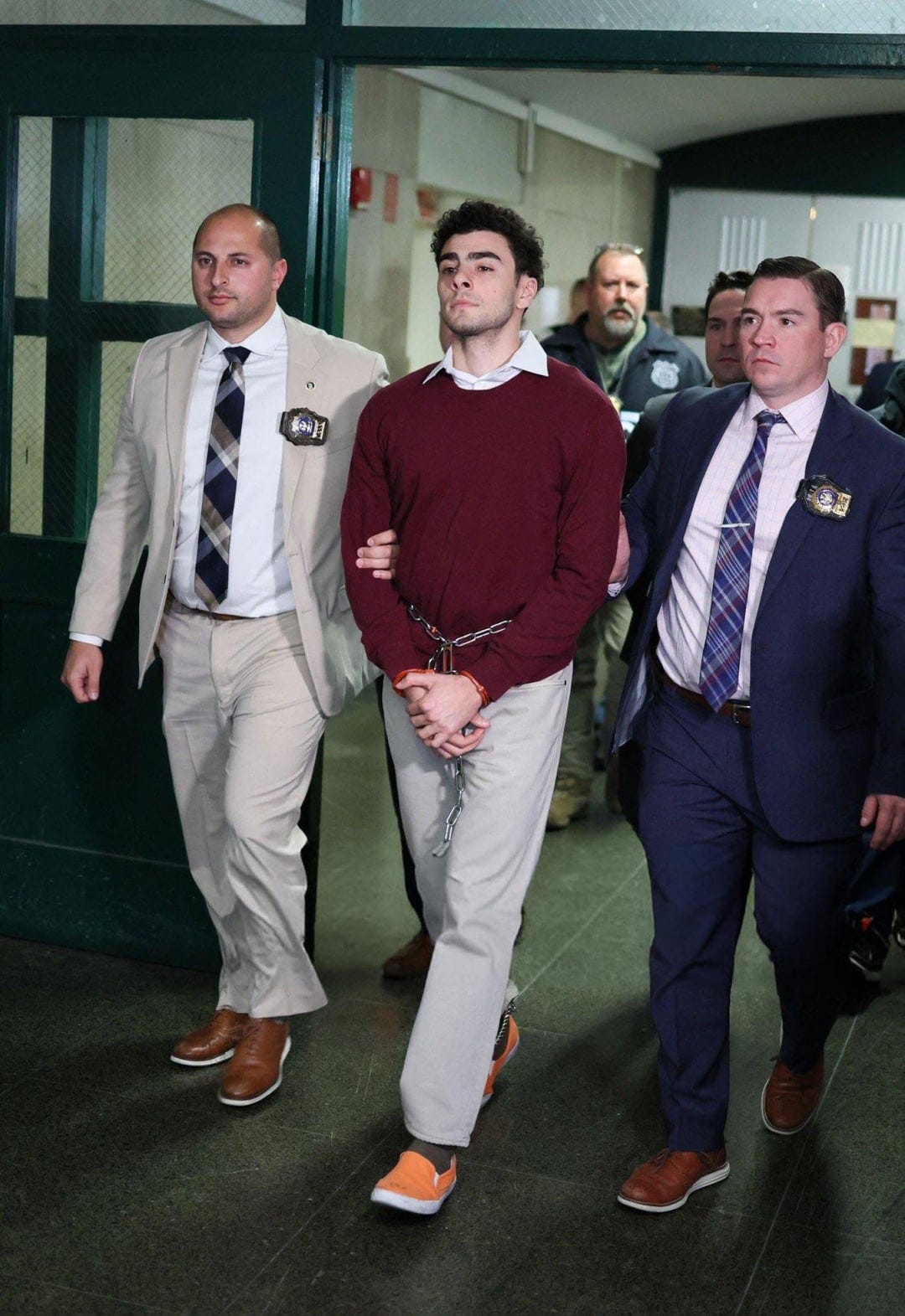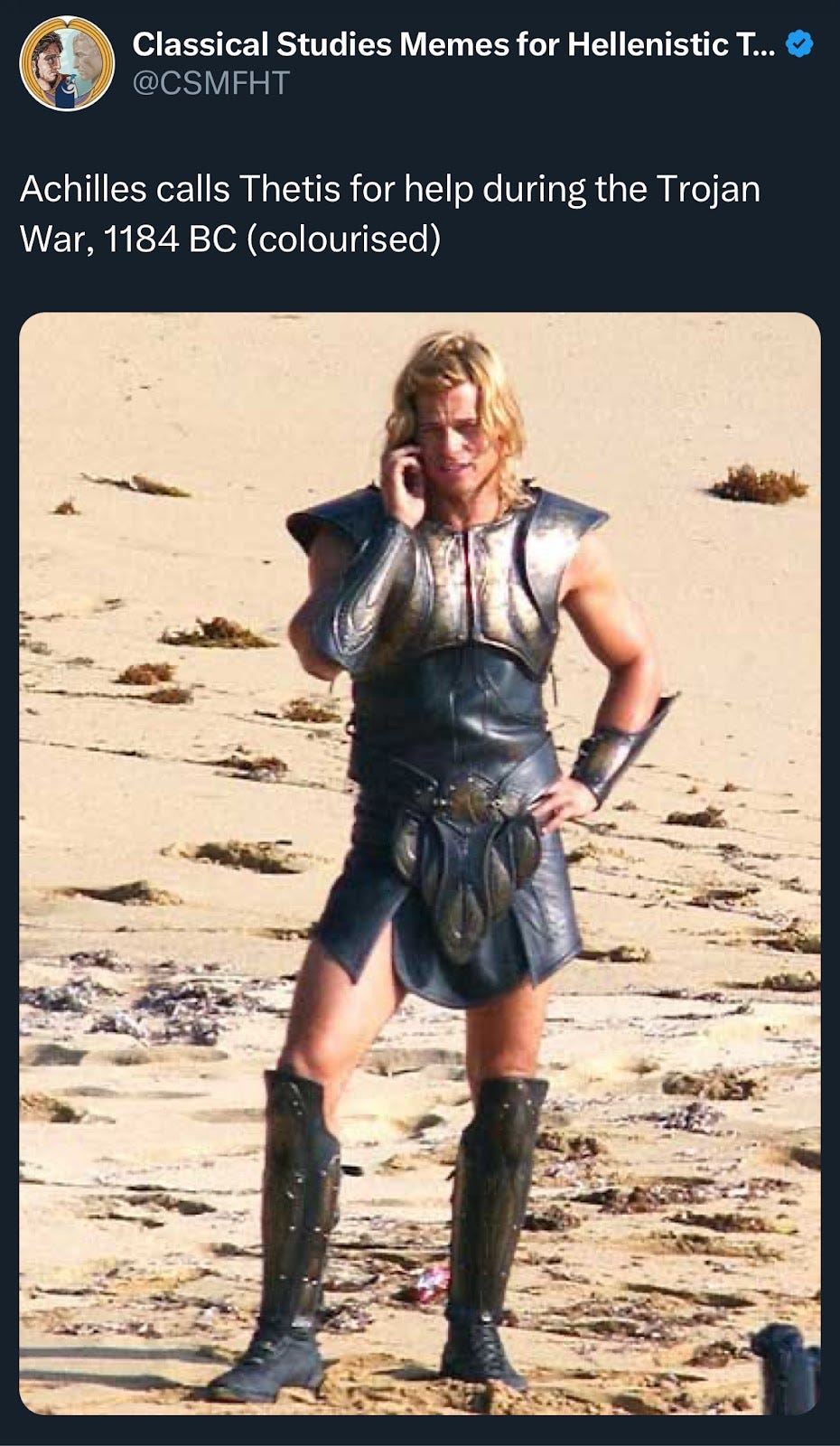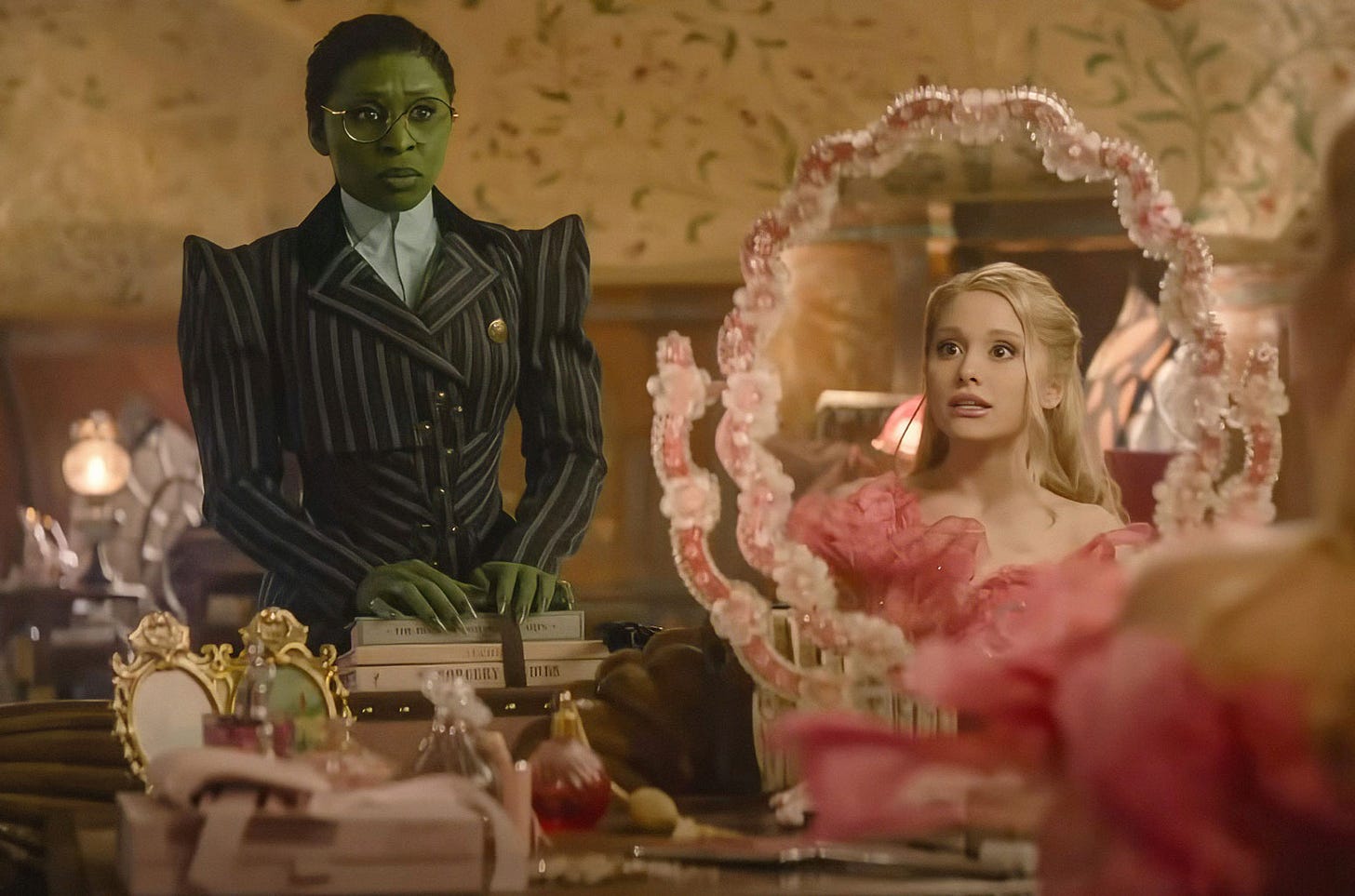Luigi Mangione’s Wicked Problem
Mangione, just like the rest of us, appears to be in Munchkinland
I wasn’t going to write about Luigi Mangione – notably because everyone has, and I think (as his lawyer does) that the story has been marred by the excessive oxygen we’ve given it. And yet, when the (alleged) assassin of the United Healthcare CEO waltzed out of court earlier this week after pleading not guilty, escorted by officers and donning a Margiela-esque jumper and little orange slippers, I realised I’d overlooked just what this man – and what I’ll be calling his Dorothy complex – says about America, the post-truth era and the modern media circus: primarily, through clothes.
Mangione heading to court in an £89 Nordstrom jumper, which has now sold out
The slippers were clearly part of Mangione’s prison uniform (a shade or two darker than his boiler suit). I confess to being unfamiliar with cell-to-court proceedings, meaning the best I can do is guesswork: but my assumption is that Mangione chose to wear the shoes he did for a reason. (It’s been confirmed that he put together the rest of the outfit himself.) In certain photographs, the orange slippers looked a tint closer to crimson: and this was probably no accident, either.
Mangione has been ripe for sartorial analysis from the start. He’s good looking, wealthy, metropolitan. While internet investigators were busy unearthing everything from his Goodreads account to his Spotify playlists, the fashion community sought out something more revealing: his wish-list on Grailed, a second-hand retail site similar to Vestiaire Collective. On it were Chrome Heart X Rick Owens sneakers, limited edition Parka jackets by Raf Simons and an Enfants Riches Déprimés sweatshirt. For the non-linguists, the French brand translates to Depressed Rich Kids, which is a fairly apt description of Mangione himself.
Of course, this is uncertain material – no one has independently verified whether this was indeed Mangione’s wish-list, or that of a joker/opportunist posing as the man of the season. But that’s beside the point. In truth, enough people wanted to believe this was Mangione’s wish-list, and were all too happy to assign meaning and interpretation where appropriate. A bit like I’m about to do with the slippers.
What’s revealing about the wish-list – whether authentic or fake – is its deferral to cult designers for cultish audiences. Owens, Simons and their affiliates (e.g. Dries Van Noten) are the marques of the connoisseur. Maison Margiela – where John Galliano has been creative director for 12 years – is the most emblematic of the lot, with their Spring 2024 collection voted the best of the year by Vogue readers this month. No wonder, then, that the fashion girlies – whose enthusiasm for Mangione knows no bounds – wanted to believe he was wearing a £1,000 Margiela jumper at his hearing this week and not, as it really was, an £89 number from Nordstrom. What we know about Mangione is, really, what we want to know about him.
It’s unclear whether Mangione fancies himself a connoisseur, but the facts of the case – the letter that was found with him by the authorities, the verified social media accounts and his elite education – suggest he sees himself at least as enlightened; someone who’s escaped the Matrix and has a duty to the world. Maison Margiela, Raf Simons and Rick Owens – derivative, challenging clothes worn by people with an inflated sense of self-importance – fit seamlessly into the assassin’s proverbial wardrobe. Jonathan Haidt, an NYU professor whose book The Anxious Generation was among those on Mangione’s Goodreads, has described the American youth as being “coddled”: indulged and underboiled. The killer, at age 26, perfectly embodies this dialectic: spoiled and overinflated yet critically lacking in reason. The ideas underpinning his murder of Brian Thompson were both ideologically overblown and intellectually underbaked – a bit like the aforementioned designers whom he may or may not have been wearing.
But what to make of the clothes he has definitely been wearing? What do the crew-neck jumper, the facemask that gave him away (rather like the cloth in Othello, come to think of it), the newly threaded eyebrows (which some speculate were done by a fellow inmate in Pennsylvania) and, yes, the enigmatic slippers tell us about a country in search of a post-American dream hero?
To some, Mangione is akin to the Menendez Brothers: hot killers given an easy ride by a horny and adoring public. To others, he’s like Anna Delvey, the con artist who posed as an heiress and took wealthy, unsuspecting trust fund babies for a ride (take that, corporate America!). Both readings, however, underplay the power of his uniform: and the most accurate analogy, obvious since his courtroom appearance this week, is to Dorothy Gale from the Wizard of Oz.
Dorothy is, of course, front and centre of the public consciousness at the moment thanks to the smash hit movie adaptation of the musical, Wicked, itself adapted from Frank L Baum’s classic books and the 1939 film starring Judy Garland.
In the original story, Dorothy and her house are swept up in a tornado that takes her from Kansas to the magical land of Oz, where she is guided by Glinda The Good Witch to subdue the Wicked Witch of the West and expose the Wizard as a fraud. Not that her intentions are ever set out that clearly. Dorothy’s actions have consequences, but think of who’s really behind them. It is, indeed, Glinda who reveals the power of the red slippers to the heroine, long after she first gives them to her. The Witch keeps Dorothy in Oz for long enough to help her remove her rivals in a cunning race to dominance: only then do Dorothy and her dog, Toto, get to go home.
The red shoes are one of Hollywood’s most enduring symbols. Mangione’s tango with the media and own sense of style, meanwhile, suggest someone acutely aware of the power of dress. His decision to don his own version of the red slippers in court was, I think, deliberate: even if they did come straight from his prison cell. And if he’d owned a pair of cherry-red Flabelus or Vibi Venezia loafers, and had the right to wear them in court (again, I’m hazy on the details), I like to think he would have chosen those instead. (Although they wouldn’t have squared too well with the Rick Owens-heavy Grailed wishlist. Too preppy.)
The distinct flavour of Mangione’s Saviour Complex – proselytic and carefully curated, with an accompanying letter tracing the thought process behind the killing – is really a Dorothy Complex. Because even though some believe that he sees himself, rather pathetically, as a hero, all students of literature know that heroes are not really their own agents. From Hercules to Hector (and indeed to Dorothy herself), they are at the mercy of powers greater than them. In fact, the possible nod to Judy Garland’s character is the closest Mangione has come to enlightenment in the saga he’s managed to whip up: he is, his lawyer might argue, just a pawn. The circumstantial evidence against him is damning: so why plead not guilty if not to make precisely this point?
Such a defense might imply that Brian Thompson was a pawn as well: an NPC in the American tragedy where Big Deities are replaced with Big Money. In which case, Mangione’s murder was not really a murder at all. Bingo: you’re off the hook.
This has, indeed, been the assassin’s advantage from the start – the complete dehumanisation of the victim. How often has Thompson’s name featured in articles and on social media, compared to Mangione’s? The myth is not about the man who scaled the American dream – a husband and father of two shot down in the prime of his life – but about the hot, privileged killer, one whose every spoken word, move and outfit end up part of a greater narrative which, so far, seems to have spawned more column inches than Assad’s departure from Syria.
To explore the idea of tragedy a little further: there’s also something distinctly Aeschylean about the “Deny”, “Defend” and “Depose” bullet casings curated by Mangione. Who is he, he asks, but a messenger; an oracle whose sole power is to warn, not undo? The same Americans who feel the system is stacked against them have thus found in the son of country club owners an unlikely champion. And in the post-truth economy, anything goes: a trust fund baby makes a convincing freedom fighter.
In a world where Wicked means Good and Good means Ruthless, John M Chu’s Wicked could not have come at a better time.
This might be the canonical reading – but as Wicked continues to prove, retellings are in: so let’s try something else. What if the Wicked Witch of the West had faked her death? What if Brian Thompson’s murder was just for show? What if true wickedness continues to lurk – or, as in Wicked, was always elsewhere?
Knowing who is what in this saga – who’s good, who’s evil – is precisely what’s kept it going for as long as it has. Even though it really should be as simple as there is a murderer; there is a murderee.
Which brings me to another recent box office hit: The Substance. In the denouement (spoiler alert), the monstrous creature Demi Moore has become has to stick a printout of her old face onto her new one while on stage for a TV special. “It’s me!” she tries to tell the audience, as horror impends. When Mangione pouts for his mugshot or is pictured smiling gleefully in a car en route to his trial or having an outburst during his extradition, he too is changing masks; revealing costumes; donning a new face. The eyebrow threading; the cute outfits that may or may not be high fashion – his trick is to confuse, and by doing so, to seduce. Case in point: the Nordstrom jumper sold out just days after he wore it.
Fashion, with its seasonal switches and constant churn of novelty, does the same. So far, it’s been Mangione’s greatest weapon. But when he’s in court saying “L’oracle, c’est moi”, he risks doing so in the same way that the monster in The Substance tries to utter the words “it’s me” but can’t because its mouth is being pulled apart by flesh and a breast is bulging out of its cheek.
William Hosie is the editor of Gauche Magazine










